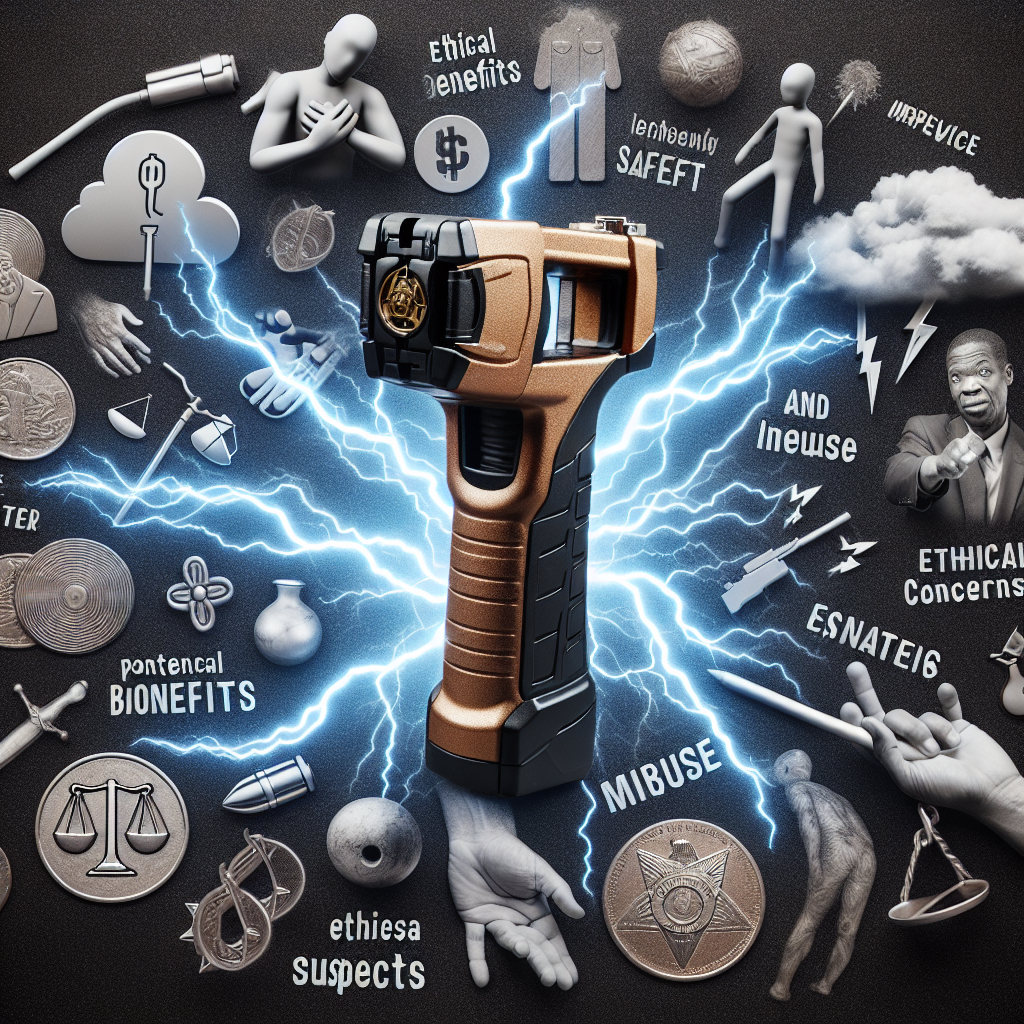Imagine a world where law enforcement officers have a powerful tool that allows them to effectively maintain public safety while minimizing the use of lethal force. Enter the Taser, a device that has revolutionized law enforcement by providing a non-lethal alternative for subduing suspects. In this article, we will explore the impact of Taser usage in law enforcement, examining how these devices have reshaped the way officers approach their duties and the implications it has for the communities they serve. From reducing officer injuries to decreasing the number of civilian casualties, the implementation of Tasers has undoubtedly transformed policing for the better. So, let’s delve into this remarkable innovation and uncover the remarkable changes it has brought about in the world of law enforcement.

Table of Contents
ToggleOverview of Taser Usage in Law Enforcement
Definition of a Taser
A Taser, also known as a conducted energy weapon (CEW), is a non-lethal weapon used by law enforcement agencies to incapacitate individuals temporarily. It operates by delivering electrical pulses to disrupt voluntary control of muscles, effectively immobilizing or incapacitating the target. Tasers typically have two metal prongs that are shot from a distance and attach to the target’s clothing or skin, delivering the electric shock.
History of Taser Usage in Law Enforcement
The use of Tasers in law enforcement traces back to the 1970s when their development began. The invention of the Taser was credited to Jack Cover, a NASA physicist, who introduced the first model known as “Tom Swift’s Electronic Rifle.” However, it was not until the early 1990s that Tasers gained popularity among law enforcement agencies as a less-lethal alternative to firearms.
Evolution of Taser Technology
Over the years, Taser technology has significantly evolved, incorporating advancements to enhance effectiveness and safety. Early models had limited range and were bulkier, but advancements in battery technology and miniaturization have led to more compact and lightweight designs. Additionally, new-generation Tasers have introduced wireless probes, improved targeting systems, and integrated safety features to minimize the risk of accidental discharges.
Current Use of Tasers by Law Enforcement Agencies
Tasers have become widely adopted by law enforcement agencies across the globe. They are primarily used in situations where non-lethal force is necessary to subdue an individual who poses a threat to themselves, officers, or others. However, specific guidelines and protocols vary among agencies regarding when and how Tasers should be deployed. Training plays a crucial role in ensuring proper usage and minimizing the potential for misuse.
Advantages of Taser Usage
Non-lethal Alternative to Firearms
One of the primary advantages of using Tasers in law enforcement is their non-lethal nature. When faced with potentially dangerous situations, officers have the option to use a tool that reduces the likelihood of fatalities. Tasers provide an alternative to firearms, allowing law enforcement to mitigate potential risks to suspects and officers while still maintaining control over the situation.
Reduced Risk of Fatalities and Injuries
Compared to traditional firearms, Tasers have been shown to significantly decrease the risk of fatalities and injuries. Studies have indicated that the use of Tasers can help prevent lethal encounters, as the electrical shocks they deliver temporarily disable individuals without causing severe harm. By using Tasers, law enforcement can effectively neutralize threats while minimizing the potential for fatal outcomes.
Decreased Use of Other Force Options
The introduction of Tasers in law enforcement has contributed to a decrease in the use of other potentially harmful force options. Officers are often faced with situations where the use of physical force, batons, or pepper spray may be necessary. However, Tasers provide an additional tool that can deter aggressive behavior and reduce the need for more intrusive force, ultimately promoting a safer environment for both officers and the public.
Enhanced Officer Safety
Tasers have proven to be valuable in enhancing officer safety. By providing a less-lethal option for dealing with threatening individuals, law enforcement officers can better protect themselves from harm. The ability to immobilize resisting suspects from a distance reduces the need for close physical contact, potentially minimizing the risk of injuries to officers during confrontations.
Effective Weapon for Subduing Resistant or Threatening Individuals
One of the key advantages of Tasers is their effectiveness in subduing individuals who are resistant or pose a threat to others. By delivering short bursts of electrical energy, Tasers can temporarily disrupt an individual’s voluntary control of muscles, making it difficult for them to resist arrest or cause harm. This non-lethal approach offers law enforcement officers a means to gain control over challenging situations while reducing the chance of causing significant harm.
Controversies and Concerns
Public Perception and Negative Media Coverage
Despite their benefits, Tasers have faced significant public scrutiny and negative media coverage. Incidents where their use resulted in serious injuries or deaths have raised concerns about their safety and appropriate usage. Media focus on these cases has contributed to a perception that Tasers are more dangerous than often reported, leading to public distrust and skepticism about their widespread use in law enforcement.
Misuse and Abuse of Tasers by Law Enforcement Officers
One of the controversies surrounding Taser usage relates to the potential misuse and abuse of these weapons by law enforcement officers. Instances of excessive or unnecessary force involving Tasers have garnered significant attention. Inappropriate use of Tasers, such as deploying them as a punitive measure rather than as a tool to neutralize threats, undermines their intended purpose and raises questions about officer accountability and the need for stricter guidelines.
Potential for Misjudgment and Excessive Force
The ability to deploy Tasers in various situations presents the challenge of proper judgment by law enforcement officers. In high-stress or rapidly evolving scenarios, there is a risk of misjudgment when deciding whether to use a Taser or other force options. Additionally, concerns have been raised about the potential for excessive force in situations where the use of Tasers may not be warranted, leading to unnecessary harm or even fatalities.
Health Risks and Potential Long-term Effects
While Tasers are generally considered a safer alternative to firearms, there are still health risks associated with their usage. Although studies have shown a low incidence of severe injuries, there have been cases where Tasers have contributed to adverse health effects, particularly in individuals with pre-existing medical conditions or who are under the influence of drugs. The potential long-term effects of repeated Taser usage on both suspects and officers require further research and consideration.
Disproportionate Impact on Vulnerable Populations
Concerns have been raised regarding the disproportionate impact of Taser usage on vulnerable populations, such as individuals with mental illness, the elderly, or those from marginalized communities. The potential for miscommunication or misinterpretation of behaviors could result in unnecessary or unwarranted deployment of Tasers, exacerbating existing disparities and raising questions about fairness and equity in law enforcement practices.
Legal and Ethical Considerations
Legislation and Policies on Taser Usage
Taser usage is regulated by legislation and policies in many jurisdictions to ensure appropriate and responsible deployment. These laws define when and under what circumstances Tasers can be used by law enforcement officers. They often include guidelines on the level of threat required and the proportionality of force, as well as reporting and documentation requirements. Legislative frameworks aim to strike a balance between public safety and preserving individual rights.
Code of Conduct and Training for Law Enforcement Officers
To ensure the responsible use of Tasers, law enforcement agencies implement specific codes of conduct and provide training on their usage. Officers are educated about the ethical considerations, de-escalation techniques, and the appropriate use of force continuum. Ongoing training and refresher courses ensure that officers are equipped with the necessary skills and knowledge to make informed decisions regarding Taser deployment.
Accountability and Oversight Mechanisms
Accountability and oversight mechanisms play a crucial role in maintaining public trust and confidence in law enforcement agencies. Independent review boards, internal affairs divisions, and civilian oversight committees work to ensure that the use of Tasers, among other force options, is subject to rigorous scrutiny. These mechanisms help identify potential abuses or misconduct, promote transparency, and hold officers accountable for their actions.
Use of Tasers as Torture Devices or Cruel and Unusual Punishment
The use of Tasers as a means of torture or cruel and unusual punishment is a significant ethical concern. Cases where Tasers have been inappropriately deployed, excessively used, or intentionally misused raise questions about human rights violations. Strict regulations and oversight are essential to prevent the misuse of Tasers and ensure their usage aligns with ethical standards and international human rights obligations.
Civil Liberties and Human Rights Concerns
The use of Tasers in law enforcement also raises civil liberties and human rights concerns. The potential for abuse and the impact on an individual’s right to personal security and freedom from excessive force require careful consideration. Balancing the need for public safety with upholding civil liberties is an ongoing challenge for law enforcement agencies, requiring continuous assessment and refinement of policies and practices.
Effects on Police-Community Relations
Perceived Bias and Discrimination
The use of Tasers, like any other force option, can contribute to perceptions of bias and discrimination in law enforcement practices. Concerns have been raised that certain populations face a higher likelihood of being subjected to Taser usage, leading to distrust and strained relationships with law enforcement. Transparency, accountability, and addressing systemic biases are essential for building trust and ensuring fair treatment within communities.
Trust and Confidence in Law Enforcement
The responsible and transparent use of Tasers is crucial for building trust and confidence between law enforcement agencies and the communities they serve. When individuals see that Tasers are deployed appropriately, within the bounds of the law, and with proper oversight, it can enhance perceptions of fairness and legitimacy in law enforcement actions. Fostering positive police-community relations requires open dialogue, community engagement, and proactive efforts to address concerns related to Taser usage.
Impact on Community Policing
Community policing relies on trust, cooperation, and collaboration between law enforcement and community members. The use of Tasers can affect the effectiveness of community policing efforts, particularly if their usage is perceived as excessive or unjustified. Striking a balance between maintaining public safety and engaging in community-oriented policing practices is crucial for enhancing the overall well-being and security of neighborhoods.
Role of Transparency and Data Reporting
Transparency and data reporting play a significant role in addressing concerns related to Taser usage. Collecting and analyzing data on Taser deployments can provide insights into their impact, patterns of usage, and potential biases. Publicly sharing this information enables communities to better understand the rationale behind Taser usage and promotes accountability. Transparent reporting contributes to more informed discussions on law enforcement practices and encourages trust-building efforts.
Use of Force Continuum and Policies
Understanding the Use of Force Continuum
The use of force continuum is a framework that provides guidance to law enforcement officers on the level of force justified in response to a given situation. It helps establish a progressive scale of force options, ranging from officer presence and verbal commands to physical force and firearms. Integrating Tasers within this continuum ensures that their deployment aligns with the principles of proportionality and the need to de-escalate whenever possible.
Integration of Tasers in Use of Force Policies
Incorporating Tasers into use of force policies enables law enforcement agencies to provide clear guidelines on their usage. Policies should include specific criteria for deploying Tasers, such as the level of threat required, restrictions on usage against certain individuals (e.g., pregnant women or juveniles), and guidelines for post-usage reporting and documentation. Regular review and updates to these policies ensure that they reflect evolving best practices and incorporate lessons learned from across jurisdictions.
Training and Education on Taser Usage
Comprehensive training and education are crucial elements in promoting responsible Taser usage among law enforcement officers. Training programs should cover topics such as understanding the physiological effects of Tasers, recognizing potential risks and limitations, de-escalation techniques, situational assessments, and decision-making skills. Ongoing education ensures that officers are equipped with the knowledge and skills necessary to make informed and ethical decisions when deploying Tasers.
Reviewing and Updating Use of Force Policies
Given the dynamic nature of law enforcement, regular reviews and updates of use of force policies are necessary. Law enforcement agencies should conduct comprehensive assessments of the effectiveness and impact of Tasers, consult with experts in the field, and engage with community stakeholders to inform any policy changes. Updating policies based on research findings, advancements in technology, and evolving societal expectations is essential to ensure responsible and accountable Taser usage.
Research and Studies on Taser Impact
Scientific Studies on Medical Effects
Scientific studies have been conducted to evaluate the medical effects of Taser usage on individuals who have been subjected to electrical shocks. Research has shown that while the risk of severe injury or fatality is relatively low, there is still a possibility of adverse physiological responses. Studies have focused on cardiac effects, the potential for injury in specific population groups, and the implications of repeated exposures. Continued scientific research plays a vital role in informing best practices and minimizing potential health risks.
Analysis of Taser Usage Data
Analyzing Taser usage data provides valuable insights into the patterns, trends, and outcomes of their deployment. Examining the frequency and circumstances of Taser usage can help identify any potential biases, guide policy decisions, and inform training protocols. Collecting comprehensive data on deployments, including demographic information, threat levels, and officer justifications, enables more evidence-based discussions on the impact and legitimacy of Tasers in law enforcement.
Comparisons with Other Use of Force Options
Comparative studies have been conducted to assess the effectiveness and safety of Tasers when compared to other use of force options. These studies often examine outcomes like rates of injuries, fatalities, or officer and suspect injuries in situations where Tasers were utilized as opposed to alternatives such as physical force or firearms. Understanding the relative effectiveness and risks associated with different force options is critical for law enforcement agencies to make informed decisions on the deployment of Tasers.
Evaluating Effects on Officer and Suspect Injuries
Research evaluating the effects of Taser usage on officer and suspect injuries provides valuable insights into the impact of these weapons in real-world scenarios. These studies assess the outcomes of encounters where Tasers were deployed, examining the rates of injuries sustained by both officers and suspects. Evaluating the overall safety profile of Tasers is essential for ensuring the well-being of both law enforcement personnel and the individuals they interact with.
Long-term Effects on Individuals Subjected to Taser Usage
Long-term effects on individuals subjected to Taser usage are an area of ongoing research. Researchers aim to understand the potential physiological, psychological, and social implications for those who have experienced electrical shocks from Tasers. Factors such as pre-existing medical conditions, repeated exposures, and the impact of Taser usage on mental health outcomes are being studied to inform policy decisions and promote the well-being of both suspects and civilians.
International Perspectives on Taser Usage
Global Adoption of Tasers in Law Enforcement
Taser usage in law enforcement extends beyond national borders, with many countries adopting these non-lethal weapons. Different jurisdictions have varying regulations and policies governing their deployment. The global adoption of Tasers reflects the recognition of their potential benefits and the need for alternatives to lethal force options. However, it also highlights the importance of addressing the potential risks and challenges associated with their usage in diverse contexts.
Variations in Approaches and Regulations
While Tasers have gained international acceptance, there are significant variations in approaches and regulations governing their use. Some countries have strict guidelines on their deployment, requiring clear justifications and reporting, while others have more lenient regulations. These variations arise from unique legal frameworks, cultural contexts, and differing interpretations of the appropriate level of force. Sharing best practices and lessons learned across jurisdictions can facilitate the development of more consistent and effective guidelines.
Challenges and Lessons Learned
International experiences have highlighted both the advantages and challenges associated with Taser usage in law enforcement. The complexities of implementing and standardizing training, policies, and oversight mechanisms require continuous evaluation and improvement. International collaboration and knowledge sharing play a vital role in identifying challenges and developing strategies to address them effectively.
International Human Rights Standards
International human rights standards provide a framework within which the usage of Tasers must be evaluated. These standards emphasize the need for law enforcement to respect the human rights and dignity of all individuals. Taser deployment should align with principles such as proportionality, necessity, accountability, and the respect for the right to life and freedom from torture or inhumane treatment. Upholding human rights obligations is crucial for ensuring the responsible and ethical use of Tasers worldwide.
Calls for Reform and Alternatives
Proposals for Restricting Taser Usage
In response to concerns and controversies surrounding Taser usage, various proposals for reform have emerged. These may include stricter regulations on when and how Tasers can be deployed, limitations on their usage against vulnerable populations, or increased accountability and oversight mechanisms. The aim of these proposals is to strike a balance between the need for public safety and the protection of individual rights and well-being.
Alternatives to Traditional Tasers
Innovation and technological advancements have paved the way for the development of alternatives to traditional Tasers. New devices are being designed to enhance effectiveness, reduce risks, and address specific challenges associated with Taser usage. For example, conducted energy devices (CEDs) featuring enhanced safety features or integrating less-painful incapacitation methods are being explored. Exploring alternatives provides an opportunity to assess their viability and potential benefits beyond traditional Taser models.
Promoting De-escalation Training and Techniques
De-escalation training and techniques have gained prominence as an alternative approach to managing confrontational situations. These strategies emphasize communication, empathy, and understanding in an attempt to defuse potentially volatile encounters. By prioritizing de-escalation techniques, law enforcement officers may be able to minimize the need for force, including the deployment of Tasers. Promoting de-escalation training provides officers with a broader spectrum of tools for resolving conflicts safely and effectively.
Psychological and Social Interventions
Recognizing that many instances involving confrontations with law enforcement involve individuals experiencing mental health crises, there is a growing call for increased psychological and social interventions. Expanding access to mental health services, crisis response teams, and training for officers in recognizing and responding to mental health issues can help reduce the reliance on Tasers and other force options. By addressing the underlying causes of confrontations, long-term outcomes may be improved and the potential for harm decreased.
Increasing Accountability and Oversight
Calls for increased accountability and oversight mechanisms have become more pronounced in recent years. Strengthening civilian review boards, expanding the authority and independence of internal affairs divisions, or introducing body-worn camera requirements are some of the proposed measures to enhance transparency and accountability related to Taser usage. These mechanisms aim to build public trust, hold law enforcement officers accountable for their actions, and foster a culture of responsible and ethical policing.
Conclusion and Future Outlook
Summarizing the Impact of Taser Usage
The usage of Tasers in law enforcement has both advantages and drawbacks. Tasers provide a valuable non-lethal alternative to firearms, reducing the risk of fatalities and injuries in potentially volatile situations while decreasing the use of other force options. They enhance officer safety and are effective for subduing resistant or threatening individuals. However, controversies and concerns around their usage necessitate careful evaluation and ongoing improvements.
Balancing Benefits and Risks
Striking a balance between the benefits and risks of Taser usage is crucial. Law enforcement agencies must carefully consider the potential health risks, societal impacts, and ethical considerations associated with their deployment. Ongoing research, comprehensive policies, responsible training, and robust oversight mechanisms are vital for ensuring the responsible and ethical use of Tasers.
Emerging Technologies and Innovations
The future of Taser usage in law enforcement will likely be shaped by emerging technologies and innovations. New advancements may focus on improving safety features, reducing potential risks, and integrating alternative incapacitation methods. Research and development efforts will continue to explore the possibilities of less-lethal force options, including optimizing the effectiveness and safety of Tasers.
The Evolving Role of Tasers in Law Enforcement
As law enforcement agencies navigate complex challenges and strive to improve community relations, the role of Tasers will undoubtedly evolve. Balancing technological advancements with ethical considerations, transparency, and engagement with communities will shape the responsible usage of Tasers. Incorporating lessons learned from research and international experiences will contribute to more effective policies, enhanced training, and a more comprehensive understanding of the impact of Taser usage in law enforcement.
In conclusion, Tasers have become an integral part of law enforcement’s non-lethal force options. They offer advantages such as reduced risk of fatalities, enhanced officer safety, and effectiveness in subduing resistant individuals. However, controversies, concerns, and calls for reform highlight the need for ongoing evaluation, research, training, and policy development. Striving for responsible Taser usage, balancing the benefits and risks, and promoting accountability will be key as law enforcement agencies navigate the evolving landscape of less-lethal force options.













